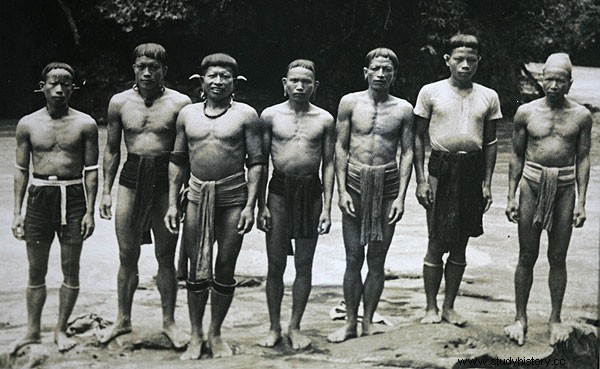On November 16, 1944, a United States Army Air Forces B-24 bomber (USAAF ) crashed in the Borneo jungle after being shot down by the Japanese. Seven of the ten crew members of the plane managed to parachute before the plane crashed in the middle of the jungle. Their lives had been saved… for now .

Crew of the crashed B-24
The survivors gathered and moved away from the accident area so as not to be located by the Japanese patrols, but they ran into the Dayak -the indigenous people of Borneo feared for their ancient tradition of cutting off heads-. Contrary to what was expected, according to the legends that circulated around the Dayak, the meeting was friendly and meant the salvation of the Americans. They were taken to their village where their wounds were treated and, most importantly, they were hidden from the Japanese. Two issues played in favor of the Americans:the fact that the old custom of cutting off heads It had been abandoned after the passage through the island of the Christian missionaries and the evangelization of the Dayak, and their enmity with the Japanese for subjugating them and having massacred the missionaries. For several months they lived with the Dayak until…

Practicing with the Dayak blowguns
On March 25, 1945, Tom Harrisson , anthropologist and commander of the British Army, and 7 Australian members of the Z Special Unit -corps unit Special Operations Australia (SOA ), created to operate behind Japanese lines in Southeast Asia - were parachuted onto the island with the mission of rescuing downed pilots and raising the Dayak against the Japanese. The Unit managed to contact the indigenous people and prepared to flee from the island. While the evacuation plan was being studied, Harrison was able to convince the Dayaks to put aside their passive resistance against the Japanese and engage them in guerrilla warfare in the jungle… as well as recovering the custom of cut off heads . They became a nightmare for the Japanese.
Finally, and with the help of the Dayak, a flat area of the dense jungle was cleared and a landing strip was made with bamboo to give it consistency so that a small aircraft could land. In June 1945, after seven months on the island, the American pilots left the island.

Dayak in 1945
